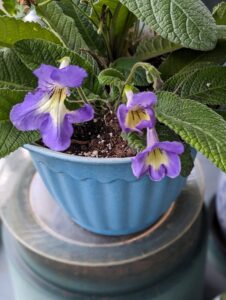 Right now, in mid-July, the roses are taking a mid-season rest, while the daisies—coneflowers, coreopsis and Shastas—take center stage. I love them all, but at this moment I am absolutely infatuated with the streptocarpus plants that are currently strutting their flowery stuff on my covered front porch.
Right now, in mid-July, the roses are taking a mid-season rest, while the daisies—coneflowers, coreopsis and Shastas—take center stage. I love them all, but at this moment I am absolutely infatuated with the streptocarpus plants that are currently strutting their flowery stuff on my covered front porch.
The name “streptocarpus” is awful, invoking virulent sore throats and other painful ailments. Streptocarpus plants have nothing to do with the Streptococcus bacteria that causes sore throats and everything to do with the classical Greek words “streptos”, meaning twisted, and “karpos”, indicating fruit. I have never looked closely at the fruits that succeed the flowers on my streptocarpus plants, but they are contained in the twisted capsules that gave rise to the Latin genus name.
Streptocarpus is commonly known as “Cape primrose”, a much better name that invokes images of faraway places and dainty spring flowers. “Cape” refers to South Africa, home to some of the ancestors of today’s hybrid Cape primroses. “Primrose” has little to do with the common primroses that most of us grow in our spring gardens. It was probably just a reference to the delicate appearance of the flowers, and/or the lettuce-like leaf configuration, which resembles the basal rosettes of primrose family members.
I have grown streptocarpus at various times over the years, and the three specimens that are flourishing on my front porch right now are the best ones yet. All “streptos” are beautiful, growing 12 to 18 inches tall and wide, with basal rosettes of soft, round to elongated foliage that tends to be wrinkled in appearance. The flowers are borne above those leaves on relatively short stems. Each bloom is composed of an elongated tube that flares out into five petals, which are sometimes frilled on the edges. Many of the fancier streptocarpus feature iris-like petal configurations, with two upper petals and three lower petals. The blooms may be tinted white, yellow, pink, red, blue-purple, purple or bi-colored. Sometimes the petals are also marked with contrasting throats, dots or “whiskers” reminiscent of pansies or even orchids. A mature plant will bear many flowers at a time and bloom repeatedly over the course of a year.
The streptocarpus genus is part of the large Gesneriaceae or African violet family and the plants have many of the recognizable African violet traits—including the range of flower colors, care requirements and light preferences. Some people find Cape primroses easier to grow, but I think both require similar amounts of care and attention and offer the same levels of gratification. In my experience, streptos bloom more frequently.
It takes many species to make a modern outdoor or indoor ornamental plant. The showy Cape primroses that are starting to appear in nurseries and garden centers now were bred from species like Streptocarpus primulifolius, introduced from South Africa to Europe in 1826, and Streptocarpus dunnii, which made it to Europe in 1886. The latter was a red-flowered species that got breeders at England’s Kew gardens excited and most likely helped them widen the available range of flower colors. In the twentieth century, two English horticultural firms, Veitch and John Innes, made wide inroads in breeding, including irradiation of plants to produce even more colors. Breeders also developed compact varieties that can be grown in three or four-inch pots.
Online nurseries offer an impressive array of streptocarpus. I especially love the elegant ‘Bristol’s Cool Breeze’ with pale yellow throats, medium purple upper petals and pale purple lower ones. You might also satisfy your inner Victorianist with a variety like ‘Holka’, boasting frilly petals that are pink at the top of each flower and yellow, edged in pink at the bottom.
Choosing just one or two varieties may be the hardest part of the Cape primrose experience.
When you receive your plant in the mail from a specialty vendor or bring it home from a nursery, inspect for pests or signs of disease. Providing there are none, place in the bright, indirect light provided by a north, east or west-facing window. Refrain from killing your Cape primrose with the kindness of giving it too much water. Water only when the top of the soil looks and feels dry, and avoid splashing leaves, as it causes unattractive spotting. I use an organic liquid fertilizer diluted according to manufacturer’s directions.
Beyond those minimal maintenance functions, all you really have to do is deadhead the spent flowers and remove any dying leaves from the plant. Plants will sometimes go dormant after they flower. If this is the case, don’t despair, just water minimally and stop feeding. In a month or two, the plant will revive and start its growth cycle again.
Like the evil streptococcus bacteria, streptocarpus plants can be quite contagious.
If you are itching to catch the streptocarpus bug, visit any large nursery or garden center. If their supplies are lacking, go to Logee’s Greenhouses, 141 North Street, Danielson, CT 06239, (888) 330-8038, www.logees.com. Another wonderful supplier is Violet Barn, PO Box 9, Naples, NY 14512; (585) 374-8592; www.violetbarn.com.
